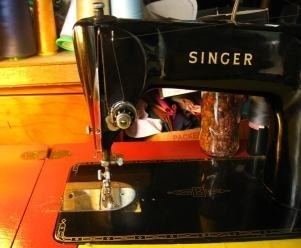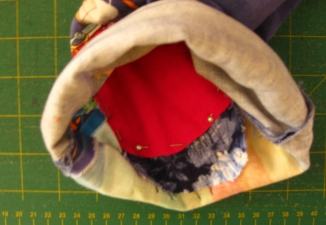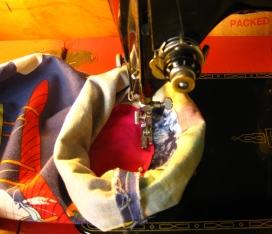Patching and Darning using a Flat Bed Sewing Machine
It is quite straight forward to use a flat bed sewing machine to repair the knees of jeans and other pants. This tutorial shows you one way of patching and darning.
I am using a treadle powered Singer 201K sewing machine which does straight stitching only - no zigzag.

Gather together your supplies: pants needing mending, scrap fabric for the patch, scissors, pins and sewing machine.
Use a durable fabric for the patch. If you are placing it on the inside
of the garment, like I am in this example, make sure that it will be
comfortable for the wearer.

The knees in these pants (originally upcycled from an old curtain) have worn through before, but my daughter begged me to repair them yet again.
The stitching below the frayed hole is where a previous patch has been applied.

View of the inside of the hole.
You can see the previous patch that I applied. Note how the stitching
extends beyond the edge of the old patch.
This strengthens the whole area of the knee - but obviously not quite enough!

Cut a patch of fabric a bit larger than the area of the hole or worn fabric that you need to cover. I like to use a diamond or round shape cut so most edges are on the diagonal. This reduces fraying.

I have rolled up the leg of the pants. This is Part One of the magic trick that enables you to easily access the area where you will be sewing.

Pin the patch onto the inside of the leg of the pants. If you want to make a feature of the patch, then I recommend that you follow these directions to the end, and then sew a decorative patch on the outside at the end of the darning process.

This is Part Two of the magic trick to be able to do this darning and mending on a flat bed machine. Turn the leg of the pants so that top of your stitching is on the INSIDE.

Getting ready to sew the patch onto the inside of the pants. This is sometimes called "sewing inside the cup".
Reduce the foot pressure on your machine (if possible). This lets you
manipulate the fabric more easily.

To reduce fraying, I decided to do a rough zigzag style stitch around the edge of the patch. My machine only does straight stitch so I allowed the feed dogs to pull the fabric through while stitching forward and then I pulled it back towards me to made the other part of the zigzag.

Showing how the new patch (pink flannelette) is now stitched onto the inside of the knee.

Showing the outside of the patch. My zigzags are very rough because my daughter said she would like it to be like fireworks. If you prefer a neater finish then you can use straight stitching or another decorative stitch if it is availabe on your machine.
Note how the edges of the hole are frayed and worn. Use your fingers to press the threads down flat.

Turn the leg of the pants inside out. Roll the cuff up again so that you can get at the area where you want to sew.

Now I am going to go back and forwards over the worn and frayed fabric, sewing it firmly onto the patch fabric at the back.
In this picture, I have done one pass over the hole.
See that wispy bit of fabric? Make sure that it lies flat as you stitch so you do not end up with it getting caught around the foot of the machine.

Make a second pass at stitching across the hole. Extend the stitching out to the original zigzagging that you used to attach the patch.
Contine sitching until you have a firm to very firm patch.
In the next photo you can see that I have made three sets of stitching - one lot up and down, one lot from left top to bottom right and a final lot from right top to bottom left.

All done and ready for another hard day climbing trees and sliding down poles!
Please note that this particular example is not pretty - but the child wanted "fire works". However if you have a thread colour that blends with your garment, the patch can be quite insignificant.
Another option is to sew a decorative patch on the outside over the top of your darning.






